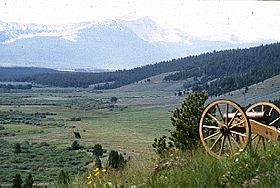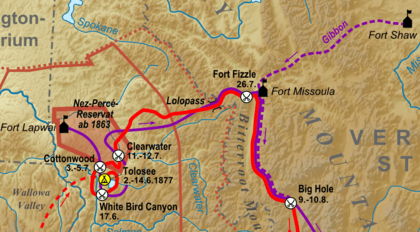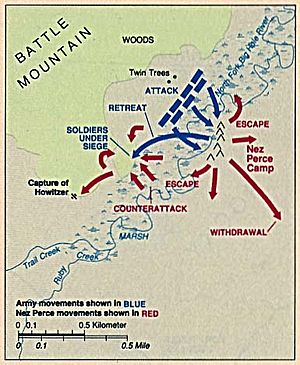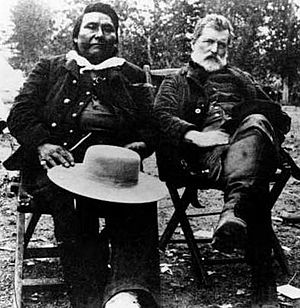Battle of the Big Hole facts for kids
Quick facts for kids Battle of the Big Hole |
|||||||
|---|---|---|---|---|---|---|---|
| Part of the Nez Perce War | |||||||
 Big Hole battlefield |
|||||||
|
|||||||
| Belligerents | |||||||
| Nez Perce | |||||||
| Commanders and leaders | |||||||
| John Gibbon | Chief Joseph Looking Glass |
||||||
| Strength | |||||||
| 206 | 200 warriors | ||||||
| Casualties and losses | |||||||
| 31 killed 38 wounded |
70–90 killed of whom perhaps thirty were warriors. | ||||||
The Battle of the Big Hole was a major fight during the Nez Perce War. It happened in Montana Territory on August 9–10, 1877. This battle was between the United States Army and the Nez Perce tribe, a group of Native Americans. Both sides had many losses. The Nez Perce left the battle in an organized way. They continued their long journey, trying to reach Canada for safety. The battle site is now the Big Hole National Battlefield. It is located in Beaverhead County, Montana.
Contents
Why the Battle Happened
After the Battle of the Clearwater in Idaho Territory in July 1877, the Nez Perce leaders guided their people on a long journey. They wanted to escape the soldiers led by Brigadier General Oliver Otis Howard.
The Nez Perce traveled into Montana Territory through the tough Lolo Pass. They had a short meeting at Fort Fizzle on July 28. Then, they entered the Bitterroot Valley and moved south.
Looking Glass Takes Charge
Looking Glass seemed to take over leadership from Chief Joseph. He promised the white settlers in the Bitterroot Valley that the Nez Perce would pass peacefully. They kept their word, even trading with local merchants for supplies.
Looking Glass convinced the Nez Perce that General Howard was far behind them. He also believed that the people of Montana did not want to fight them. Because of this, the Nez Perce traveled slowly. They did not set up guards or send out scouts to watch for danger.
They left the Bitterroot Valley, crossed a mountain range, and camped in the Big Hole Basin. They stopped to get new poles for their tipis from the nearby forest. There were about 750 Nez Perce people in total, with around 200 warriors.
Gibbon's Surprise Attack
The Nez Perce did not know that Colonel John Gibbon was coming. He had left Fort Shaw with 161 soldiers and one howitzer (a type of cannon). He also gathered 45 civilian volunteers in the Bitterroot Valley.
On August 8, a small group led by Lieutenant James Bradley found the Nez Perce camp. It was located along the North Fork of the Big Hole River. That night, Gibbon marched his men to the camp. They arrived at dawn, leaving the howitzer and supplies to follow later. Gibbon planned to fight, with orders to take no prisoners and have no talks.
The Battle Begins
Gibbon's soldiers were between their position and the Nez Perce camp. The camp had 89 tipis shaped like a "V". The North Fork of the Big Hole River was between them, with water up to their waists and lined with willow trees.
At dawn, Gibbon's men walked towards the Nez Perce camp. They met an old Nez Perce man and killed him. The soldiers crossed the river and rushed into the village. They began shooting into the tipis where most of the Nez Perce were still sleeping.
The Nez Perce were caught off guard and ran in all directions. The soldiers fired at everyone. Some Nez Perce women were also armed and shot back. Lieutenant James H. Bradley, leading Gibbon's left side, was killed early. His men lost their leader and did not keep moving forward. This left the northern part of the village open, giving the Nez Perce a safe place to gather.
Nez Perce Fight Back
Gibbon stopped his men from chasing the Nez Perce too far. He ordered them to burn the tipis. This was hard to do, and the pause gave the Nez Perce time to get organized. The soldiers heard the voices of White Bird and Looking Glass rallying their men.
From hidden spots, the Nez Perce began to shoot back. Gibbon's horse was hit, and he was wounded in the leg. Several other soldiers were killed. The Nez Perce were very good shots. However, according to the warrior Yellow Wolf, most Nez Perce warriors had run away without their weapons. Only a few were armed.
Soldiers Retreat
About twenty minutes after entering the village, Gibbon realized his position was not safe. He ordered a retreat across the river to a wooded area. This area was about 300 to 400 yards away and out of sight of the village. The soldiers dug trenches and built barriers from rocks and logs.
At this point, Gibbon's howitzer arrived. It fired a few shots that did not do much damage. The Nez Perce killed or wounded most of the howitzer crew. The crew left the gun, but not before taking it apart.
Gibbon worried that the Nez Perce would attack his position. He thought they outnumbered him, though they probably did not. Instead, the battle became a sniping fight. About 60 Nez Perce warriors, led by Ollokot, shot at the soldiers. The Nez Perce had collected weapons and ammunition left by the soldiers.
At one point, the Nez Perce started fires to try and burn the soldiers out. But the wind changed, and the fire died out. That afternoon, the Nez Perce kept shooting at the soldiers. Meanwhile, their women packed up, gathered the horses, and moved south. They traveled about 18 miles to Lake Creek, where they set up camp. This time, they built defenses.
A Difficult Night
Gibbon faced serious problems that night. His men had no food, except for a dead horse. They had no water, and many men were badly wounded. Some water was brought from the river by volunteers who sneaked through the Nez Perce lines. Several civilian volunteers had had enough and left the battle. Gibbon sent messengers to find General Howard's larger force, asking for immediate help.
The next day, August 10, twenty to thirty Nez Perce sharpshooters kept the soldiers trapped in their defenses all day. The Nez Perce warriors left that night. They left Gibbon and his soldiers alone, but unable to move from the battlefield. Howard, with an advance group of 29 cavalrymen and 17 Bannock scouts, found Gibbon the next morning. They had ridden 71 miles in a day and a night.
Who Won and What Happened Next
The battle was very costly for both sides. Gibbon's soldiers were too hurt to chase the Nez Perce. Gibbon's force had 29 dead (23 soldiers and six civilian volunteers) and 40 wounded (36 soldiers and four civilians). Two of the wounded later died. More than 30 percent of his force were casualties.
There is no exact number for Nez Perce losses. However, between 70 and 90 Nez Perce people likely died. Less than 33 of these were warriors; most were women and children. Yellow Wolf said that only 12 "real fighters" died. Chief Joseph's and his brother Ollokot's wives were wounded.
Changes in Leadership
Gibbon's surprise attack caused Looking Glass to lose respect as a leader. He had promised the Nez Perce they would be safe in Montana. Instead, almost every Nez Perce family suffered a loss in the battle. Chief Joseph seemed to take back his role as the main leader of the Nez Perce. However, Looking Glass continued to be a battle leader.
For the Nez Perce, the losses were very sad. They had hoped that by leaving Idaho, the war would be over. Now, they knew they could expect no mercy in future fights. General Howard's forces arrived at the battlefield and began chasing Joseph's group. They followed them towards Yellowstone National Park. The Nez Perce fought the army again ten days later, on August 20, at the Battle of Camas Meadows.
The battle site is now part of the Big Hole National Battlefield. This is a unit of the Nez Perce National Historical Park. You can find it along State Highway 43.
|





